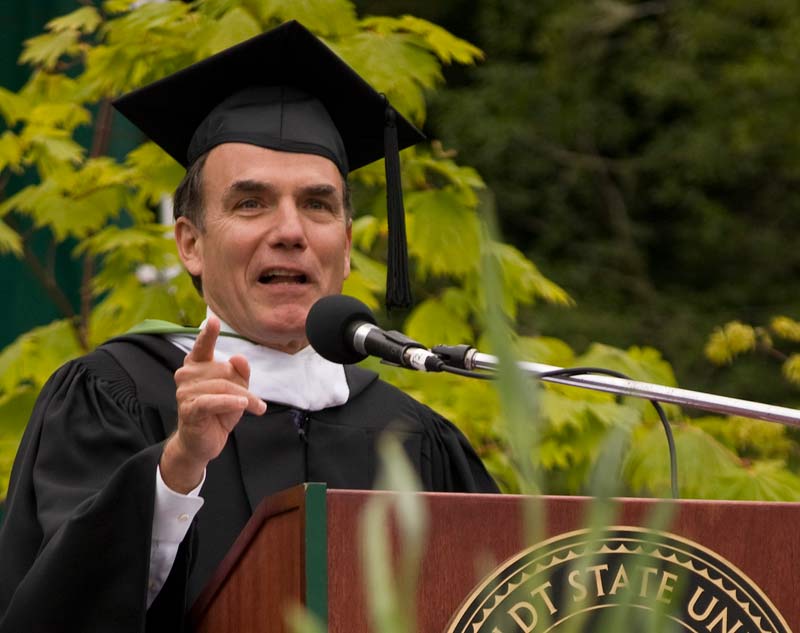Embracing Change: A newspaper editor’s advice to the Class of 2010
May 21st, 2010 Posted in OpinionBy John Diaz, Editorial Page Editor
San Francisco Chronicle
Editor’s Note: John Diaz, editorial page editor of the San Francisco Chronicle, returned to his alma mater last weekend for what has to be a most daunting assignment—to deliver the commencement address to the next cohort of job-seekers. Here are excerpts of the 1977 journalism graduate’s address at Humboldt State University in Arcata, Calif.
Your generation has lived through a period of great change: in technology, in the way we work and travel … in the status of the United States in the world. Lots of folks in my generation are struggling with change. You embrace it, you expect it—you are ready to create it. This is one of your greatest assets as you go into your respective professions.
My business, the news business, is just one of many industries that must change as a matter of survival. Change is also likely to define your world whether you are leaving here with a degree in oceanography, forestry, child development, sociology or any other discipline.
For some of you—perhaps most of you—the newspaper itself has become as obsolete as the Sony Walkman or the VCR. But the demand for new songs did not go away just because college students started downloading music for “free.” To me, as an editor, our real challenge is to keep producing content that people want and need … and the technology and the business model will follow.
See, I really am an optimist.
My goal in life is to preserve the standards and values of journalism in whatever form it is delivered. As one of my professors here, the late Howard Seemann, used to tell me: Don’t be co-opted by the culture of the organization you’re in … if it involves shortcutting quality or lapses in ethics. Set your own standards, the highest standards, of the organization you want to work for and the person you want to be. This approach will never fail you, he assured me. He was right. In 33 years, it never has.
As I look around the nation, at the collapse of public faith in our institutions—banking, government and, yes, sadly, in too many cases, journalism—I only wish that others were exposed to the wisdom of Howard Seemann.
The way people communicate with each other is something that I think about all the time—and not just because I’m in the communications business. I’m also a parent, and I marvel at the way our speed and method of communication has evolved.
It’s amazing how easy it is to stay in touch. I love getting text messages from my daughter in college. Then again, I also wince from time to time when I see those Facebook postings from Saturday night.
I would not turn the clock back if I could. Modern communications offer us ways to create communities—and even fight repression—with a power that could not be imagined not long ago. I think about the protesters in Iran, and how they used their mobile phones to stay in touch. Technology can be a great friend of democracy.
But there are downsides to this remarkable era: There is a danger of falling too much in love with technology. It can even be hazardous to your health. A recent story in my newspaper surveyed doctors who are seeing a whole new wave of injuries resulting from hand-held devices, from the rather obvious—the “BlackBerry thumb”—to spinal strain caused by people constantly looking down to send and read text messages.
And, of course, the increasingly apparent dangers of calling or texting while driving are leading to new laws in many states, including ours. Laws that seem to be widely ignored, unfortunately.
The age of information is also the age of disinformation.
Conspiracy theories and outright falsehoods gain unwarranted credence on an unfiltered, unaccountable World Wide Web. Think of all the times you’ve heard someone cite, “I saw it on the Internet,” as evidence of something. It may be right, it may be distortion, it may be outright fabrication. Don’t lose your skepticism. Beware of those mirages of truth in the vast expanse of information.
As amazing as technology can be, it can dull us to the experience of real life. I think about the times I have seen someone on a backwoods hike with music roaring in his ear buds, missing all the subtle sounds of nature. Or the times someone in the next row at the ballpark is texting messages or chatting on the phone instead of interacting with the people he or she came with. I think about those scenes with President Obama in a rope line and all the cell-phone cameras rising above the crowd from people more determined to get a snapshot than to experience the fleeting moment of real human eye contact they can never recapture.
It has been said that 80 percent of life is showing up. But is being virtually connected the same as showing up? I don’t think so. A thousand Facebook friends is not equivalent to having one friend who will sit there, and listen to you, in a moment of need.
Genuine human interaction does not always fit within 140-character tweets. Sometimes your silent presence can be as powerful—as reassuring, as comforting—as the fullest e-mail in-box in the world.
—John Diaz is The Chronicle’s editorial page editor. You can e-mail him at jdiaz@sfchronicle.com. http://sfgate.com/cgi-bin/article.cgi?f=/c/a/2010/05/16/INS81D45L5.DTL This article is reproduced with the permission of the author.
TP


Sorry, comments for this entry are closed at this time.